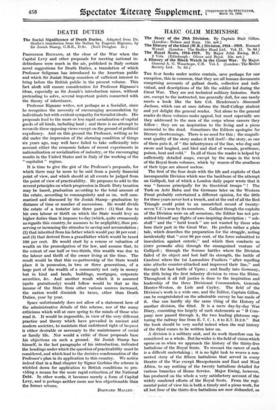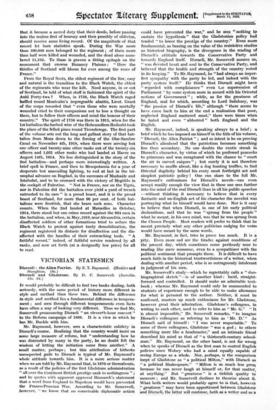HAEC.. OLIM MEMINISSE
The Story of the 29th Division. By Captain Stair _Gillon. (London : Nelson and Sons. 15s. net.)
2 Vols. (Edinburgh : Oliver and Boyd. 25s. net.)
Tim four books under notice contain, save perhaps for one exception, this in common, that they are all human documents comprising accounts of gallant deeds, collective and indi- vidual, and descriptions of the life the soldier led during the Great War. They are not technical military histories. Such are, except to the instructed, too generally dull, for one rarely meets a book like the • late Col. Henderson's - Stonewall Jackson, which can• at once inform the Staff-College student and yet delight the. general reader. Not alone to the general reader do these volumes make appeal, but most especially are they addressed to the men of the corps whose careers they follow : they are an inspiration to the living and a pious memorial to the dead. Soinetimes the Editors apologize for literary shortcomings. There is no need Tor this ; the magnifi; cent quality of the story makes it tell itself—the story, as one of them puts it, of ". the infantrymen of the line, who dug and swore and laughed, and bled and died of wounds, pestilence; poison, heat and cold." In all of them the reader is helped by sufficiently detailed maps, except by the maps in the text of the Royal Scots volumes, which by reason of the smallness of their type are almost useless.
The first of the four deals with the life and exploits of that incomparable Division which was the backbone of the attempt on Gallipoli, but of which a London daily paper wrote that it was " famous principally for its theatrical troupe " ! The Turk on Achi Baba and the Germans later on the Western Front probably entertained a different opinion, for the 29th for three yearS never lost a trench, and at the end of all the Red Triangle could point to an unmatched record of twenty- seven V.C.'s won by its members. Gallant though the exploits of :the Division were on all occasions, -the Editor has not per- mitted himself any flights of awe-inspiring description r " sob- stuff " and the " lurid touch " are not wanted by those who bore their part in the Great War. He prefers rather a plain tale, which describes the preparation for the struggle; noting incidentally that " over 99 per cent. of the force submitted to inoculation against enteric," and which then conducts us (inter permulta • alio) through the ensanguined venture of Gallipoli ; through the Somme battles where the Division failed of its object and lost half- its strength, the battle of Cambrai where the 1st Lancashire Fusiliers " after repelling nine attacks counter-attacked and improved their line," and through the last battle of Ypres ; and finally into Germany, the 29th being the first infantry division to cross the Rhine. Throughout it all full jnstice is done to the inspiration and leadership of the three Divisional Commanders, Generals Hunter-Weston, de Lisle and Cayley. The field of the Division's work is a wide one, and the Editor, Captain Gillon, can be congratulated on the admirable survey he has made of it. One can hardly sfiy the same thing of the History of another division, the 62nd. It is a mere day-by-day War Diary, consisting too largely of such statements as " B Com- pany now passed through A, the two leading platoons cap- turing the railway line from E. 7. C. 1. 8 to E.7. D.2.9." But the book should be very useful indeed when the real history of the 62nd comes to be written later on.
A division is a- military unit, and its work therefore can be considered as a whole. But far wider is the field of vision which opens on us when we approach the history of the thirty-five battalions of the Royal Scots. To recount the career of such is a difficult undertaking ; it is no light task to weave a con- nected story of the fifteen battalions that served in every theatre of the War except Mesopotamia and East and West Africa, to say nothing of the twenty battalions detailed for various branches of- Home Service. Major Ewing, however, has produced on the whole a very satisfactory account of the widely sundered efforts of the Royal Scots. From the regi- mental point of view his is both a timely and a pious work, for all but four of the thirty-five battalions are now disbanded, so
that it became a sacred duty that their deeds, before passing into the realms first of hearsay and then possibly of oblivion, should receive some living record. Of the magnitude of that record let bare statistics speak. During the War more than 100,000 men belonged to the regiment ; of them more than half were killed and wounded, and the dead alone num- bered 11,162. To these is graven a fitting epitaph on the monument that crowns Buzancy Plateau : " Here the thistles of Scotland will bloom for ever_ among the roses of France."
From the Royal Scots, the eldest regiment of the line, easy and natural is the transition to the Black Watch, the eldest of the regiments who wear the kilt. Need anyone, in or out of Scotland, be told of what stuff is fashioned the spirit of the Auld Forty-twa ? When, in 1758, the Black Watch raged baffled round Montealni's impregnable abattis, Lieut. Grant of the corps recorded that " even those who were mortally wounded cried to their companions not to lose a thought on them, but to follow their officers and mind the honour of their country." The spirit of 1758 was there in 1915, when for the 1st battalion the barbed wire of the Hohenzollern Redoubt took the place of the felled pines round Ticonderoga. The first part of the volume sets out the long and gallant story of that bat- talion from Mons down to the forcing of the Oise-Sambre Canal on November 4th, 1918, when there were serving but one officer and twenty-nine other ranks out of the twenty-six officers and 1,081 other ranks who had landed at Havre on August 14th, 1914. No less distinguished is the story of the 2nd battalion—and perhaps more interestingly written. A brief spell in France, and then to Mesopotamia for a year of desperate but unavailing fighting, to end at last in the tri- umphal advance on Bagdad, in the successes of Mushaide and Istabulat, and to be crowned with the victory of Megiddo in the cockpit of Palestine. " Not in France, nor on the Tigris, nor in Palestine did the battalion ever yield a yard of trench entrusted to its care " is a proud boast, and it is the proud boast of Scotland, for more than 90 per cent. of both bat- talions were Scottish, that she bears such sons. Character counts. When the 2nd landed at Marseilles in October, 1914, there stood but one crime record against the 984 men in the battalion, and when, in May,1919, near Alexandria,Certain disaffected soldiers of other formations tried to seduce the Black Watch to protest against tardy demobilization, the regiment registered its distaste for disaffection and the dis- affected with the handles of their entrenching tools. " A faithful record," indeed, of faithful service rendered by all ranks, and now set forth (at a designedly low price) for all to read.































































 Previous page
Previous page